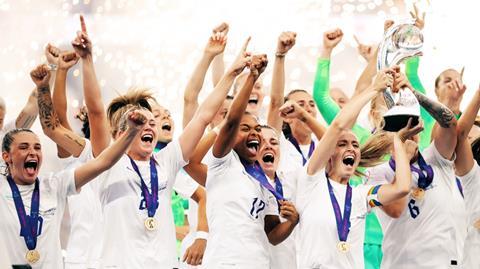Lisa Thompson, strategy lead at WPP Media’s Wavemaker

With the Women’s European Championships kicking off in Switzerland, fans look forward to the pinnacle moment in this summer’s lineup for women’s sports. We’ve already seen a huge spike in interest following the Women’s Rugby Six Nations in March, with England triumphantly taking victory in a narrow 43-42 win against France. Now all eyes are on the pitch as football looks to capture the same momentum, ready to inspire the next wave of sporting heroes.
I live for these moments, as a football fan who has been visiting Elland Road since I was five, I often wish I could go back and start playing football. However, in the mid-90s that just wasn’t an option. The facilities just weren’t there. One of the reasons I am inspired by my best friend’s little girl is that it’s normal for her to put on her boots every Sunday and go and show the boys how it’s done. The reason it’s so normal is largely due to the Lionesses.
However, it’s reported that broadcast audiences for women’s football have dropped by 35%. For an industry that’s fought so hard to get women’s sport the visibility it deserves, this may feel like a punch to the gut.
But we need to look beyond the surface. This isn’t a sign of dwindling interest. It’s a reflection of shifting behaviour. Fans haven’t disappeared; they’ve moved and their preferences have evolved. If broadcasters and brands want to keep pace, they’ll need to follow.
Audiences are still growing - just not where you’re looking
While linear TV numbers may have dropped, engagement with women’s sports is thriving in other areas. TikTok, YouTube, podcasts, creator-led content, WhatsApp support groups - this is where the next generation of fans are forming connections. They’re after more than the matchday experience. They want stories, personalities, cultural context and moments of joy that sit outside the 90 minutes.
Take the rise of the Lionesses Live content series, which provides fans with a window into the training sessions, dressing room dynamics and player personalities of the England squad; or Inside The WSL, which Sky Sports launched to bring more depth, analysis, and storytelling to the women’s game. On the BBC, Alex Scott’s increasing presence across flagship programmes like Football Focus and Match of the Day is proof that more inclusive coverage helps bring women’s sport into the mainstream, not as a separate category, but as part of the whole.
What’s more, coverage of women’s sport is finding fresh audiences via digital platforms like DAZN, which made the UEFA Women’s Champions League free-to-view on YouTube - a bold move that grew awareness and broke down accessibility barriers.
It’s not just in content; crowds are growing in stadiums. I live in Manchester and during matches for the women’s games, the town and the trams are busier, and this comes with a lovely buzz you don’t feel at the men’s games. This creates a great opportunity for brands to tap into crowds.
Broadcasters need to adapt to this emotional-first trend. Rather than viewing TV ratings as the be-all end-all, they should see them as a mandate to modernise and go beyond live coverage and build an offering that’s multiplatform, fan-first and continuous. Women’s football doesn’t only exist during tournaments, and coverage shouldn’t either.
Beyond the spotlight
The Women’s Euros may be the headline event, but the real work growing the game happens behind the scenes - in community centres, school pitches, Sunday leagues and social content feeds. It’s here that broadcasters have the greatest chance to make lasting change.
We’ve seen how powerful this can be. Sport England’s This Girl Can, celebrating its 10th anniversary, wasn’t built on elite sport. It was built on the messy, joyful, everyday realities of women moving their bodies on their terms. This advertising campaign resonated because it wasn’t aspirational; it was accessible. It didn’t just drive awareness, it drove participation. Over three million women became more active in its first year alone.
For broadcasters being serious about supporting women in sport, the brief is clear: don’t just turn up when the cameras are rolling. Show up when the floodlights are off. Support the infrastructure, fund the coaching and give a platform to the stories that don’t end in a trophy lift.
From sponsors to stakeholders
The list of global sponsors backing the Women’s Euros - Adidas, Amazon, AXA, Booking.com - signals a shift in how women’s football is valued commercially. The challenge is now to ensure sponsorships evolve into something more meaningful.
Real impact comes from treating these partnerships as cultural commitments, not seasonal marketing exercises. That might mean funding media platforms that cover women’s sport all year round. Supporting education programmes that encourage girls to get into coaching and refereeing. Investing in fan experiences designed with female audiences in mind, from merchandise to stadium accessibility to digital communities.
BT Sport’s Ultimate Goal reality series shone a light on the talent pipeline behind the game. Meanwhile, EA Sports FC’s inclusion of women’s leagues and players in its flagship game signals to a younger generation that women’s football is football, not a spinoff.
The Women’s Euros will undoubtedly deliver magical moments on the pitch. But the legacy we build around it will matter far more. That means championing women’s sports when it’s not in the headlines. And showing up for all women, not just the ones with a new logo on their shirt.
Fans are still here. They’re still watching. Just not in the same old ways. The question is: are you willing to meet them where they are?

Lisa Thompson is strategy lead at WPP Media’s Wavemaker





No comments yet